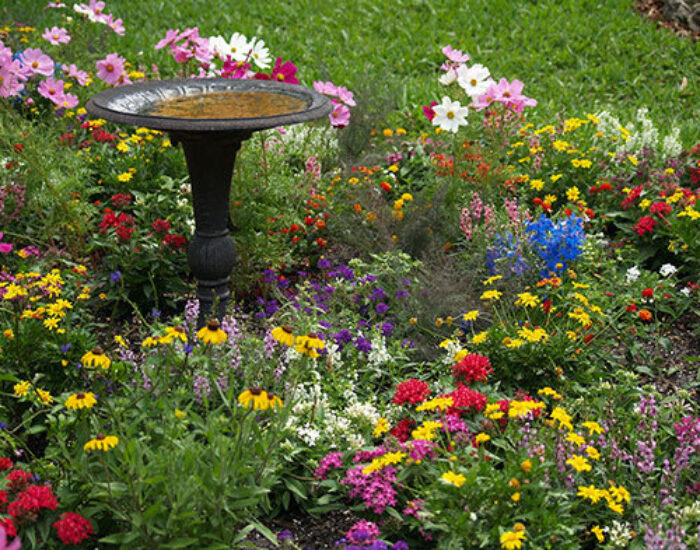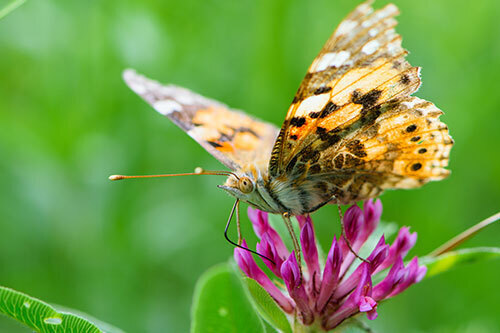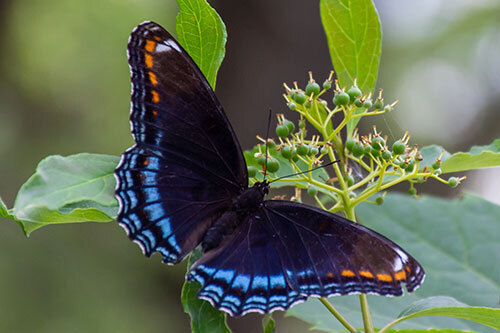March 23rd, 2022
Creating A Butterfly Garden in Your Yard

As the weather gets warmer, it’s an ideal time of the year to color your backyard with vibrant plants and flowers. Pollinator gardens have been trending for the past couple of years specifically planted and designed to attract butterflies by supplying food in the form of pollen. Here are a few unique species of butterfly indigenous to the midwest, each provided with their preferred nectar source:
Monarch (Danaus plexippus)
With its colorful black and orange wing patterns, the Monarch is easy to recognize in your garden setting and is considered a Midwest favorite. Native species of Milkweed tend to be the most common food of choice for Monarch caterpillars and provide much needed nourishment. In addition, lantana, echinacea, flowering sages, verbena and joe-pye weed are also local lure for this type of butterfly.
Cabbage White (Pieris rapae), Orange Sulphur (Colias eurytheme)
The Pieridae family of butterflies includes both the Cabbage White and Orange Sulphur type that are mostly found in tropics, and fancy coneflowers. These caterpillars’ favorite foods are alfalfa, clover, mustard and peppergrass. When you encounter this caterpillar in the wild, it is entertaining to watch them eat. They tend to eat from the stem to the tip and will completely eat one side of the leaf before moving on to the other.

Painted Lady (Vanessa cardui)
This species, also known as the Cosmopolitan, is the most widespread butterfly in the world. They migrate through the midwest area each spring. These caterpillars prefer to eat thistles, hollyhock and mallow while adult Painted Ladies go for plants that are from three to six feet tall like aster, red clover, buttonbush, blazing star, cosmos and joe-pye wee.
Black Swallowtail (Papilio polyxenes)
During the spring to fall seasons, you will typically see three generations of Black Swallowtails. In their larvae stage, they crave many plantings typically found in vegetable gardens: parsley, dill and the tops of carrots. Meanwhile, adult Black Swallowtails gravitate towards nectar sources that include zennias, bee balm, lantana and coneflowers. This species dramatically transforms through each stage of its development, making them a popular choice to raise for classrooms and at home.
Mourning Cloak (Nymphalis antiopa)
This large, distinctive butterfly is a welcome sign of spring in the midwest. (One of the few butterflies that hibernate as an adult, they are among the first butterflies you may notice) Once the temperature gets above 50°F, you could spot this interesting insect. You can locate them eating coneflowers, but they also may be attracted to your garden if you use overripe fruit as bait.

Red-spotted Purple (Limenitis arthemis)
This magnificent butterfly proves to be a definite showstopper when you come across them in your garden. Its black and blue wings adorned with deep orange accents and specks of white stand out against the landscape. In the larvae phase, this variety prefers to feast on the leaves of wood plants including cherry trees, poplars and aspens. This extraordinary looking caterpillar with its horns, bumps and odd shape hides among tree branches. You will find the adults visiting viburnum or privets for the rich nectar, but you’ll have more luck attracting them by leaving some overripe fruit out among your flowers.
Eastern Tiger Swallowtail (Papilio glaucus)
These yellow beauties are welcome pollinating flowers in any yard and typically produce three broods per year. Adults are partial to pink and purple flowers, particularly coneflowers, butterfly weed, phlox, lilacs and butterfly bushes. Larvae like the leaves of a variety of woody plants, including birch, cottonwood and willows.
As you can see, there is an overlap for the preferred type of Illinois native flowers among various butterflies. Some other things to keep in mind:
- Butterflies are most active during the warmest part of the day like other cold-blooded creatures. Placing large, flat rocks around your garden offers them a warm place to rest and re-charge.
- They also require dampness due to the way in which they drink. Just having water in a bowl or fountain won’t work, so be sure to keep the ground around your flowers moist.
- Plant tall grasses, such as Japanese Silver Grass, to give them some helpful shelter at night.
With a little planning, your garden will be a welcome haven for these amazing native pollinators!




